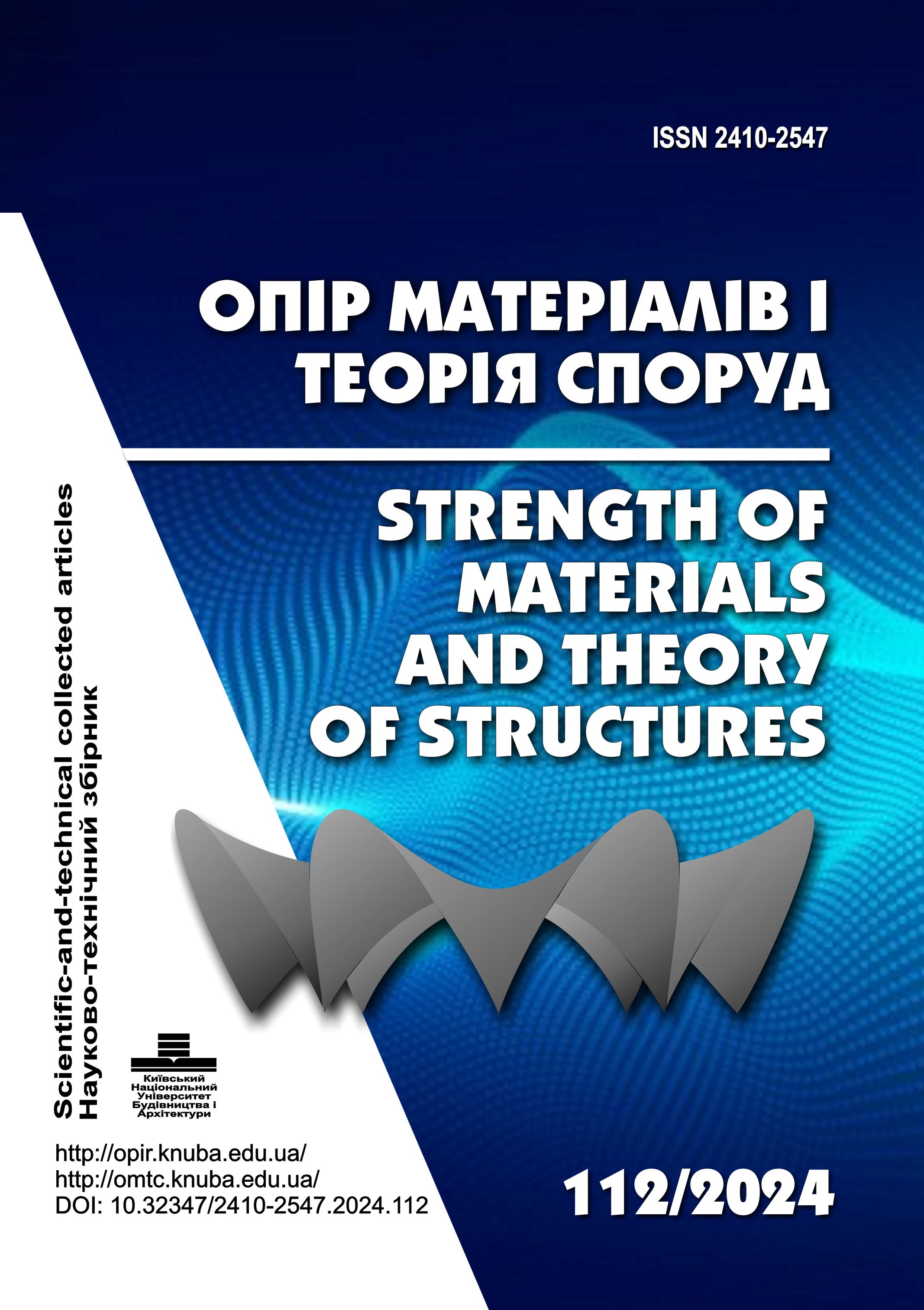The problem of the structure and the soil plastic environment interaction in the conditions of dynamic evolutionary processes
DOI:
https://doi.org/10.32347/2410-2547.2024.112.83-92Keywords:
structure, model of the soil base, elastic-plastic nonlinear environment, non-homogeneous circular and prismatic spatial bodies, dynamic loadsAbstract
Dynamic influences are one of the important factors affecting project decisions during the construction of buildings and structures. In the case of dynamic analysis, the range of possible variations in structural response is very difficult to determine. The complexity is determined not only by the parameters of the load itself (intensity, the law of change over time), but also by the characteristics of the research object (their values and change over time), which is an interconnected system of the structure and the soil base. Dynamic factors of influence can include periodic vibration or shock loads, the effects of explosions that cause a sharp change in pressure on the structure of the building, seismic fluctuations, etc. In many cases, the load is the result of stress waves propagating in the soil base. These factors can act on the natural environment long-term, relatively short-term, short-term and instantaneous. Therefore, the development of refined approaches for assessing the stress-strain state of structures during the interaction of the structure and the soil environment under the conditions of dynamic evolutionary processes remains an actual task today.
In order to effectively find a solution to the dynamics problems, it is necessary to possess the entire set of analysis tools, to clearly present the rules and limits of their application. The ability to correctly assess the engineering and geological conditions of the construction site, the properties of the soils, the joint work of these soils with the foundations and structures of the building has always been and remains the basis of reliable and effective engineering design.
The given statement of the problem is a theoretical basis to build the numerical approaches to the study of the vibrational processes of heterogeneous spatial bodies during their contact interaction with an elastic-plastic medium. The paper considers the modeling aspects of the structure and the soil elastic-plastic environment interaction under the conditions of dynamic evolutionary processes. The basic geometric and physical equations of the elasticity theory for heterogeneous circular and prismatic spatial bodies are given. In the range of solving the dynamics problem, the peculiarities of the mathematical model implementation, regarding the representation of the variation of kinetic energy as part of the equations of dynamic equilibrium of linear and nonlinear mechanical systems, are considered.
References
Bazhenov V.A, Hulyar O.I., Pyskunov S.O., Sakharov O.S. Napivanalitychnyi metod skinchenykh elementiv v zadachakh ruinuvannia prostorovykh til (Semi-analytical method of finite elements in problems of destruction of 3D bodies). – KNUCA, 2005. – 298 p.
Bazhenov V.A, Hulyar O.I., Kozak O.L., Rutkovskii V.O., Sakharov O.S. Chislennoe modelirovanie razrusheniya zhelezobetonnyih konstruktsiy po metodu konechnyih elementov (Numerical modeling of the reinforced concrete structures destruction using the finite element method). – Kyiv: Naukova dumka, 1996. – 360 p.
Bazhenov V.A, Hulyar O.I., Sakharov O.S., Solodei I.I. Napivanalitychnyi metod skinchennykh elementiv v zadachakh dynamiky prostorovykh til (Semi-analytical method of finite elements in problems of dynamics of 3D bodies). – K., KNUCA, 2012. – 248 p.
Blokh V.I. Teoria upruhosti (Elasticity theory). - Kharkiv: KHUni- 1964. –483p.
Boyko I.P. Progressivnyie metody proektirovaniya osnovaniy fundamentov na EVM (Progressive methods for designing foundations on a computer). – K.: Znanie, 1986. - 20 p.
Sakharov O.S., Kyslookii V.M., Kyrychevskii V.V. Metod konechnyih elementov v mehanike tverdyih tel (Finite element method in solid mechanics). - Kyiv: Vyscha schkola, 1982.- 479 p.
Nikolaevskii V.M. Dilatansiya i zakony neobratimogo deformirovaniya gruntov (Dilatancy and the laws of irreversible deformation of soils) // Foundations and soil mechanics. – 1979. - № 5. - P. 29-32
Sydorov V.I., Spidin V.P. Sovremennyie metodyi opredeleniya harakteristik mehanicheskih svoystv gruntov (Modern methods for determining the characteristics of the soils mechanical properties). – L., Stroyizdat, 1972. - 136 p.
Solodei I.I., Zatyliuk Gh.A. Doslidzhennia dostovirnosti ta efektyvnosti vykorystannia modelei zmitsniuvanoho gruntu v ramkakh metoda skinchennykh elementiv (Investigation of the reliability an deffectiveness of the hardening soil models use in range of the finite element method) // Strength of Materials and Theory of Structures – K.: KNUCA, 2022. – Issue 109. – P. 30-37.
Pyskunov S., Shkryl O., Maksimiuk Y. Determination of crack resistance of a tank with a semi-elliptic crack // Strength of Materials and Theory of Structures – 2021. – Vol. 106 . – P. 14-21.
Solodei I.I., PetrenkoE.Yu., ZatyliukGh.A. The stress-strain state investigation of undergroundstructures on the basis of soil models with adjusted input parameters // Strength of Materialsand Theory of Structures: Scientific-and-technical collected articles – Kyiv:KNUBA, 2019. – Issue103.– P. 63-70.
Solodei I.I., Vabishchevich M.O., Stryhun R.L. Semiаnalytical finite elements method efficiency in the geometrically nonlinear elastic-plastic problems // Strength of Materials and Theory of Structures: Scientific-and-technicalcollectedarticles – Kyiv: KNUBA, 2019. – Issue 103. – P. 71-81.
Downloads
Published
Issue
Section
License

This work is licensed under a Creative Commons Attribution 4.0 International License.
Authors retain copyright and grant the journal right of first publication with the work simultaneously licensed under a Creative Commons Attribution License that allows others to share the work with an acknowledgement of the work's authorship and initial publication in this journal.

